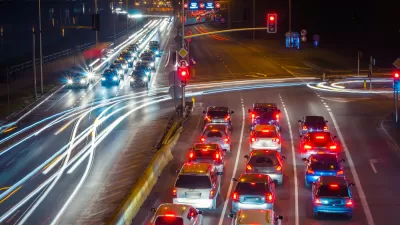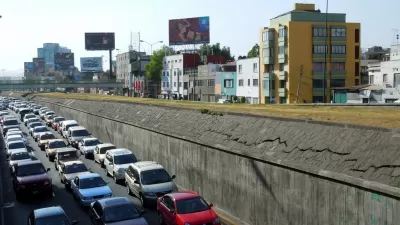A new report from the U.S. Public Interest Research Group and Frontier Group shows mounting evidence that the Millennial generation’s dramatic shift away from driving is more than temporary. Planning must change to accommodate these demands.

A new report, Millennials in Motion: Changing Travel Habits of Young Americans and the Implications for Public Policy by the U.S. Public Interest Research Group (U.S. PIRG) and Frontier Group shows mounting evidence that the Millennial generation’s dramatic shift away from driving is more than temporary. While the 2000s saw a marked decrease in the average number of miles traveled by young Americans, the study explains that those trends appear likely to continue even as the economy improves—in light of the consistency of Millennials’ surveyed preferences, a continued reduction of Millennials driving to work, and the continued decreases in per-capita driving among all Americans.
“Millennials are different from their parents, and those differences aren’t going away,” said Phineas Baxandall, Senior Analyst at U.S. PIRG and co-author of the report. “After five years of economic growth with stagnant driving, it’s time for federal and state governments to wake up to growing evidence that Millennials don’t want to drive as much as their parents did. This change has big implications and policy makers shouldn’t be asleep at the wheel.”
It includes many findings that suggest that Millennials’ shift away from driving last decade is continuing:
- Census data shows that the share of 16 to 24 year-olds traveling to work by car declined by 1.5 percentage points between 2006 and 2013, while the share of young people getting to work by public transportation, on foot or by bicycle, or else working from home, had increased.
- Young people aged 20 to 30 are less likely to move from central cities to suburbs than at any time since at least the late 1990s.
- Millennials consistently report greater attraction to less driving-intensive lifestyles — urban living, residence in “walkable” communities, and openness to the use of non-driving modes of transport—than older generations.
- Fewer young people are getting their driver’s licenses than even a few years ago. The percentage of high school seniors with driver’s licenses declined from 85 percent to 73 percent between 1996 and 2010, according to the AAA Foundation for Highway Safety, with federal data suggesting that the decline has continued since then.
Millennials are the largest generation in number and they will be the chief users of the transportation investments that get made over the coming decade. Millennials are expected to drive more as they reach the peak-driving years of middle age, but if they drive less (or even no more) than their parents did in middle age, it will be a monumental shift in travel trends since the 1950s and the assumptions underpinning current transportation policy.
Americans drive fewer total miles than we did in 2005, and fewer miles per capita than we did in the mid-1990s. People are riding public transportation more than at any time since the mid-1950s, the number of people working at home continues to surge, and bicycling has become the fastest-growing mode of commuting. Demand for housing and office space in walkable neighborhoods of many cities is outpacing the supply of new construction.
“With Millennials driving less, and showing signs they might continue to do so, it’s no longer true that the amount of driving and traffic can go in only one direction,” said Baxandall. “If Millennials are able to continue driving less than did previous generations at the same age, then America will have an opportunity for reduced traffic congestion, fewer deaths and injuries on the roads, lower expenditures for highway construction and less pollution of our air and climate.”
The report calls on public leaders to rethink their transportation investments to accommodate and encourage the Millennial generation in its desire for less car-intensive lifestyles. This includes greater investment in public transit and biking infrastructure, and using highway funds to repair of existing roads rather than building new are wider highways. State and federal governments should also assist efforts currently being led by cities to encourage walkable communities and innovative uses of technology that connect travelers to more travel options and shared vehicles.
FULL STORY: Millennials in Motion: Changing Travel Habits of Young Americans and the Implications for Public Policy

Planetizen Federal Action Tracker
A weekly monitor of how Trump’s orders and actions are impacting planners and planning in America.

Restaurant Patios Were a Pandemic Win — Why Were They so Hard to Keep?
Social distancing requirements and changes in travel patterns prompted cities to pilot new uses for street and sidewalk space. Then it got complicated.

Map: Where Senate Republicans Want to Sell Your Public Lands
For public land advocates, the Senate Republicans’ proposal to sell millions of acres of public land in the West is “the biggest fight of their careers.”

Orange County, Florida Adopts Largest US “Sprawl Repair” Code
The ‘Orange Code’ seeks to rectify decades of sprawl-inducing, car-oriented development.

Maui's Vacation Rental Debate Turns Ugly
Verbal attacks, misinformation campaigns and fistfights plague a high-stakes debate to convert thousands of vacation rentals into long-term housing.

San Francisco Suspends Traffic Calming Amidst Record Deaths
Citing “a challenging fiscal landscape,” the city will cease the program on the heels of 42 traffic deaths, including 24 pedestrians.
Urban Design for Planners 1: Software Tools
This six-course series explores essential urban design concepts using open source software and equips planners with the tools they need to participate fully in the urban design process.
Planning for Universal Design
Learn the tools for implementing Universal Design in planning regulations.
Heyer Gruel & Associates PA
JM Goldson LLC
Custer County Colorado
City of Camden Redevelopment Agency
City of Astoria
Transportation Research & Education Center (TREC) at Portland State University
Camden Redevelopment Agency
City of Claremont
Municipality of Princeton (NJ)





























